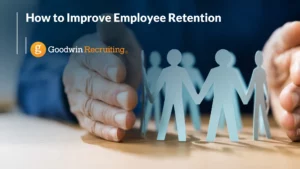How to Improve Employee Retention
Goodwin Recruiting | Hiring Advice, Leadership, Opinion | January 15, 2024

Work has evolved into more than just a way to make a living; it is now a vital aspect of our lives that significantly impacts our overall well-being. A notable trend has emerged over the years, often referred to as The Great Resignation, in which people were and still are taking risks in their quest for workplace satisfaction. Rather than settling for mediocre, people actively pursue opportunities that resonate with their passions, values, and ambitions. This shift has left many leaders grappling with how to improve employee retention. Nonetheless, research indicates that individuals are not leaving their jobs as frequently as they once did.
According to the U.S. Bureau of Labor Statistics, there was a 17% decrease in the total number of people quitting their jobs at the end of December 2023 compared to the previous year. Interestingly, the data also indicates a 2% decline in quits in December 2023 compared to pre-pandemic levels in February 2020. So, what impact might this have on your business?
As the turbulation of people leaving their jobs is starting to settle, the competition for top talent in an already tight labor market is heating up. Plus, if you lose any of your skilled employees, it’s going to cost you time and money to find someone just as great. Remember, people will still decide to leave their job if they’re not happy. And in a competitive industry, that could slow down your company’s growth.
The marketplace keeps evolving, but many businesses still deal with the same old challenges.
- How can we ensure that we have an A-team?
- How do we handle our culture, systems, and work environment?
- How can we develop exceptional leadership?
When we shift our focus to these areas, that’s when we can really help our businesses thrive in the marketplace. We can’t tackle all these issues at once, but a great starting point for many businesses is figuring out how to improve employee retention. In this blog, we’re going to talk about how to monitor your employee retention, why employees might decide to leave, and how to improve retention strategies.
How to Determine Employee Retention Rate in 4 Steps:
Having a better understanding of employee retention can really help companies make smarter business decisions. By recognizing patterns in employee tenure, companies can address issues with the work environment or employee satisfaction that may be contributing to turnover.
Keeping track of the employee retention rate is super important for organizations. It helps them see how well they’re holding onto their employees over time. To figure out the employee retention rate, just follow these steps:
- Choose how far back you want to go when calculating the retention rate and pick a starting point. Usually, this could be monthly, quarterly, or annually.
- Calculate the number of employees at the start: This is the number of employees you had at the beginning of the time period.
- Calculate the number of employees Remaining: Find out how many of the starting employees departed the organization during the specified time frame. This could involve voluntary resignations, terminations, retirements, and so on. Simply subtract the employees that left from the original group.
- Make sure to only count employees that worked during that entire time. Leave out any employees who joined anywhere in the middle of the period.
- Then insert those numbers into the basic employee retention rate formula seen below:

* For example, if you started with 200 employees, and in 3 months only 185 of those same employees remained, meaning 15 left during the period, the calculation would be: 185/200 = .925 x 100 = 92.5% Retention Rate *
- A great way to utilize the retention rate is to monitor how many new hires stick around. Hiring top talent costs more than retaining them. If you hire a new class at once , you can track how many of them stay for at least 90 days. That way, you can spot any retention issues early on. By following these steps, you can effectively determine and monitor your organization’s employee retention rate.
Finally, take a look at your retention rate and compare it to industry benchmarks or your own historical data. This will help you understand how your employee retention measures up to others in your industry and whether your efforts are improving, declining, or staying the same over time. Keep an eye out for any trends that indicate changes in your retention rate, as a low retention rate can be expensive to organizations.
Analyzing retention rates can give organizations valuable insights to make strategic decisions and prioritize efforts to improve employee retention. This kind of analysis helps identify patterns and factors leading to turnover, allowing companies to take proactive steps to address the underlying issues. However, it’s important to remember that while retention rates offer valuable insights, it’s crucial to also consider other factors impacting turnover, like industry standards, economic conditions, and organizational changes.
Why Employee Retention Rate is Important for Your Organization:
It’s obvious that keeping your top talent is crucial for helping your organization grow and succeed in the marketplace. Bringing in and holding onto new employees is a real hassle and it costs a lot of time and money. Plus, when people leave, it really messes with your team’s morale and their productivity. Keeping your employees around is what keeps your organization healthy and thriving. It’s a big deal to hire and train new people, and when they leave, it can seriously mess with your business.
In a competitive market, frequent staff turnover can harm your organization’s image as an employer of choice. Potential candidates might be reluctant to apply for roles at companies known for high turnover. On the other hand, a low turnover rate can boost your organization’s reputation as an employer and appeal to top talent.
Employee retention is crucial for maintaining a competitive edge, nurturing a positive work environment, and attaining organizational success. By prioritizing employee retention, organizations can cultivate a more steadfast, efficient, and adaptable workforce.
Reasons for Employee Turnover
When people talk about employee retention, we usually focus on satisfaction, motivation, and compensation. But we often forget about what employees expect and how we handle those expectations. Where do they see themselves going and what opportunities do they have? It’s crucial to understand why employees put in the effort at work. Can they envision a future at your company? What does that future look like, and if they work hard, will they get to experience that future? Remember, work has evolved into more than just a way to make a living; it is now a vital aspect of our lives that significantly impacts our overall well-being. So, that “future” may entail factors outside of the job and career.
Once we start grasping this root problem, we can gain a better understanding of how to enhance employee retention. So, let’s explore some of the primary reasons why individuals decide to leave their jobs to gain insight into how to effectively address these areas.
- Lack of Growth Opportunities
- If employees feel like there aren’t many chances to move up or grow professionally within the company, they might decide to leave their current roles. When there aren’t clear paths for career progression or chances to develop, it can make employees want to look for opportunities somewhere else.
- Poor Management or Leadership
- Employees might leave because they’re not happy with their managers or leaders. Things like being micromanaged, not enough communication, showing favoritism, or having leaders who aren’t effective can make people feel down and want to leave. People just want their bosses to have their back, appreciate them, and treat them with respect.
- Difficult Work-Life Balance
- Employees really care about having a good balance between work and their personal lives. If they feel too stressed out or overworked, they might end up looking for a new job. Offering flexible work options, like working from home or having a flexible schedule, can help keep these employees happy and wanting to stay.
- Lack of Recognition and Feedback
- Employees want to feel respected and appreciated for their efforts. If they don’t get recognized, receive feedback, or have chances to share their ideas and be part of decisions, they can start feeling disconnected and might even end up leaving.
- Lack of Purpose and Meaning
- Employees often want to feel like their work aligns with their values and gives them a sense of purpose. But when the organization’s values don’t match up with theirs, it can make it tough for them to find meaning in what they do. This can leave them feeling disheartened and unhappy, leading them to start looking for a new job.
- Poor Company Culture
- Organizational culture really affects how happy and committed employees are. If the work environment is toxic or just not working right, with stuff like harassment, discrimination, or bad teamwork, people will start looking for jobs somewhere else. But when the culture is positive, supportive, diverse, and matches up with what employees believe in, they’re more likely to stick around.
Improving employee retention depends on nurturing strong relationships with your team. By acknowledging employee efforts, supporting work-life balance, promoting open communication, building a positive work environment, and regularly seeking employee input, companies can keep their staff happy and committed.
The 3 R’s on How to Improve Employee Retention:
Improving employee retention means creating a positive work environment where employees feel valued, supported, and motivated to stay with the company. It may seem like a big task to improve employee retention, but it’s possible, and can be simplified if done meaningfully. Instead of giving you general strategies that you may have already tried, let’s focus on a simple, but essential concept, the 3 R’s of Employee Retention. This core concept will be helpful for your efforts, no matter what initiatives you choose to take on.
The “3 R’s of Employee Retention” are like the golden rules for keeping your team happy and sticking around. Lots of companies swear by these rules because they’re so effective. When leaders understand these principles and put them into action, they foster a workplace where employees really are committed and give their best. Now, let’s take a closer look at these 3 R’s:
Recognition:
Recognizing and appreciating employees’ contributions can really boost their happiness and drive, which helps keep them around longer. When their hard work is valued, it makes the workplace a nicer place to be, and it makes the team feel more connected and committed.
When employees feel valued, it really helps to boost their self-esteem and confidence. Recognizing their hard work and achievements not only shows that their efforts are valued, but also motivates them to keep giving their best. When employees are recognized for their work, they tend to be more satisfied with their job because they feel like their contributions are truly appreciated by the company.
Moreover, when employees are recognized and appreciated, they really step up for the company. Their loyalty grows, they get more engaged with their work, and want to see the company succeed. This kind of commitment not only helps keep more employees around, but it also boosts productivity. When people feel valued, they’re likely to give it their all, stay engaged, and look for ways to grow professionally.
Companies that make a big deal about recognizing and appreciating their employees get a lot of benefits in return. Studies show that when employees feel like they’re valued, they’re more likely to stick around, which saves the company money and keeps everything running smoothly. Plus, happy and motivated employees tend to talk up the company, making it look good and drawing in awesome new talent.
Respect:
Consider respect as the foundation of a great workplace. When everyone respects each other, it creates an environment where everyone feels valued, empowered, and ready to tackle challenges together. You know that amazing feeling of being in a place where your ideas truly count? That’s the heart of respect.
When respect is deeply rooted in the workplace, it’s like giving the whole team a boost of energy. Employees feel extra satisfied knowing that their hard work is recognized and valued. They’re not just doing their jobs; they’re fully engaged and enthusiastic about their responsibilities. Imagine being part of a close-knit team where everyone supports and roots for each other’s success.
Furthermore, when respect is at the core, employees are more likely to stay dedicated. They’re not as keen to look for other options when things get tough because they feel a strong sense of loyalty and teamwork. Plus, a happy workforce leads to better performance. It’s like a domino effect – satisfied employees mean better results for the company overall.
In essence, respect isn’t just a nice thing to have at work; it’s what makes everything work smoothly. When respect comes first, everyone, from the team to leadership, does their best. It’s the key to making sure we all succeed together!
Rewards:
Rewards are the tangible incentives and benefits that employees receive in acknowledgment of their performance and loyalty. Providing appealing rewards that employees can strive for will not only help in attracting and retaining top talent, but also show the company’s dedication to the well-being and satisfaction of its employees.
However, attractive rewards go beyond just a competitive salary. They encompass a range of benefits and perks that make working at your company a great experience. These could include comprehensive healthcare plans, flexible work arrangements, work from home options, childcare assistance, generous vacation policies, professional development opportunities, and performance-based bonuses. By offering such rewards, companies demonstrate that they value their employees and are invested in their success.
When employees feel like they’re valued and appreciated, they’re much more likely to stick around. Great perks and rewards play a big part in keeping job satisfaction up, which then helps hold onto employees better. The top candidates in the marketplace are on the lookout for companies that take care of them and provide chances to grow and achieve their personal goals.
Additionally, giving out appealing rewards can boost employee morale and motivation. When employees feel appreciated for their efforts, they tend to be more committed and productive. Ultimately, this helps the company because motivated employees are more likely to make additional efforts and drive the organization’s success.
When you bring together recognition, respect, and rewards, it really sets the stage for keeping your employees around. These are the building blocks for creating a workplace where people feel good about what they’re doing, and they’re motivated to give it their all. If you keep these 3 R’s at the core of your retention strategies, you’ll end up with a team that’s dedicated and loyal. That kind of commitment boosts productivity, cuts down on turnover costs, and helps your company thrive in the long run.
Conclusion
The marketplace is always evolving, and successful organizations will continue to prioritize attracting and retaining skilled talent. After all, employees are the heartbeat of a company! Achieving the perfect balance of hardworking and talented individuals is the key to ensuring long-term success. While organizations have always strived to recruit top talent and maintain their satisfaction, the current talent economy landscape makes this essential endeavor even more challenging.
Ultimately, a focus on improving employee retention is beneficial to any company. Improving employee retention reduces costs and fosters a more productive, innovative, and positive work environment. When it comes to attracting and keeping top talent, the candidate’s experience plays a significant role in their decision to join and remain committed to a company. At Goodwin Recruiting, we understand the challenges of recruiting and retaining top talent. Our experts can ensure that candidates have a smooth and positive experience throughout the recruitment process, leading to higher retention rates once they are hired. Get in touch today for help in building a successful team for your organization!
Share This Article














































